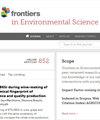通过大陆尺度合作开发的非洲地表水动态范围服务
IF 3.3
3区 环境科学与生态学
Q2 ENVIRONMENTAL SCIENCES
引用次数: 0
摘要
空间明确、接近实时的地表水动态信息对于了解水资源变化和长期水安全规划至关重要。本文介绍了自 1984 年以来整个非洲大陆的地表水分布情况,并随着每一个新的大地遥感卫星场景的出现而更新,同时首次对非洲大陆进行了验证。我们将在澳大利亚开发和测试的空间水观测(WOfS)算法应用于自 20 世纪 80 年代中期以来在非洲上空获取的每个大地遥感卫星场景,以提供过去 30 多年地表水动态的空间信息。我们利用航空和卫星图像评估了 WOfS 的准确性。在数字地球非洲产品开发工作组的协调下,四个地区地理空间组织开展了验证活动,并提供了大洲范围验证工作所需的地区专业知识和经验。我们对 2018 年 12 个月中每个月的点是潮湿、干燥还是云层覆盖进行了评估,从而获得了 34,800 个标注观测数据。由于大于 100 平方公里的水体很容易通过 Landsat 分辨率数据识别出来,从而提高准确性,因此我们屏蔽了这些水体。结果,水体分类的总体准确率为 82%。非洲的 WOfS 预计将被非洲大陆的农业和水利部、国际组织、学术界和私营部门使用。需要开展大规模的合作努力,其中包括横跨两大洲的区域和技术技能,以创建一项具有区域准确性的服务,该服务既可在非洲大陆托管,也可在非洲大陆实施。本文章由计算机程序翻译,如有差异,请以英文原文为准。
A dynamic surface water extent service for Africa developed through continental-scale collaboration
Spatially explicit, near real time information on surface water dynamics is critical for understanding changes in water resources, and for long-term water security planning. The distribution of surface water across the African continent since 1984 and updated as every new Landsat scene becomes available is presented here, and validated for the continent for the first time. We applied the Water Observations from Space (WOfS) algorithm, developed and well-tested in Australia, to every Landsat scene acquired over Africa since the mid 1980s to provide spatial information on surface water dynamics over the past 30+ years. We assessed the accuracy of WOfS using aerial and satellite imagery. Four regional geospatial organisations, coordinated through the Digital Earth Africa Product Development Task Team, conducted the validation campaign and provided both the regional expertise and experience required for a continental-scale validation effort. We assessed whether the point was wet, dry, or cloud covered, for each of the 12 months in 2018, resulting in 34,800 labelled observations. As waterbodies larger than 100 k m 2
求助全文
通过发布文献求助,成功后即可免费获取论文全文。
去求助
来源期刊

Frontiers in Environmental Science
Environmental Science-General Environmental Science
CiteScore
4.50
自引率
8.70%
发文量
2276
审稿时长
12 weeks
期刊介绍:
Our natural world is experiencing a state of rapid change unprecedented in the presence of humans. The changes affect virtually all physical, chemical and biological systems on Earth. The interaction of these systems leads to tipping points, feedbacks and amplification of effects. In virtually all cases, the causes of environmental change can be traced to human activity through either direct interventions as a consequence of pollution, or through global warming from greenhouse case emissions. Well-formulated and internationally-relevant policies to mitigate the change, or adapt to the consequences, that will ensure our ability to thrive in the coming decades are badly needed. Without proper understanding of the processes involved, and deep understanding of the likely impacts of bad decisions or inaction, the security of food, water and energy is a risk. Left unchecked shortages of these basic commodities will lead to migration, global geopolitical tension and conflict. This represents the major challenge of our time. We are the first generation to appreciate the problem and we will be judged in future by our ability to determine and take the action necessary. Appropriate knowledge of the condition of our natural world, appreciation of the changes occurring, and predictions of how the future will develop are requisite to the definition and implementation of solutions.
Frontiers in Environmental Science publishes research at the cutting edge of knowledge of our natural world and its various intersections with society. It bridges between the identification and measurement of change, comprehension of the processes responsible, and the measures needed to reduce their impact. Its aim is to assist the formulation of policies, by offering sound scientific evidence on environmental science, that will lead to a more inhabitable and sustainable world for the generations to come.
 求助内容:
求助内容: 应助结果提醒方式:
应助结果提醒方式:


